#BotW Meta
Text
I love how everyone’s talking about Link and Zelda sharing a house in totk, but I recently visited Hateno and it struck me that… it really seems like Zelda just basically kicked us out and took the house for herself?
We love making jokes abt how everyone treats him like a traveler and forgets that he was there with Zelda for certain events in the town. But what if he just. Wasn’t there. Like he literally just left Hateno because Zel went “I don’t have a house hmmmm is for me? 👉👈” and she’s the princess so what’s there to do
#totk#totk spoilers#totk meta#botw meta#loz#loz totk#legend of Zelda#the legend of Zelda#tears of the kingdom
168 notes
·
View notes
Text
the champions shouldn't come back
I’ve been seeing a lot of people say that the Champions should come back to life in TOTK, and can I just say please no. This isn’t even about shipping, I don’t give a fuck about that right now, this is about narrative.
Breath of the Wild is a story about grief. Hyrule is a grave and each ruin is a tomb. Zelda is holding the Calamity back from adding to the body count and Link is the only one who can help her stop him for good. To do that, he needs to help the kingdom move on from its death a hundred years ago. He needs to free the Champions’ spirits from the Divine Beasts and destroy Ganon and save Zelda.
Based on how the map is laid out once you get the Sheikah Slate repaired, Vah Ruta is first. It’s closes to Kakariko/Hateno and the enemies are the easiest. The game tries to subtly funnel you in that direction with the random Zora laid out in the area, searching for Hylians for Prince Sidon, and there’s a reason for that, narratively.
(or there isn’t and I’m reaching, but bear with me)
Mipha was Link’s childhood friend. She (and Zora’s Domain as a location) is the representation of his youth and the child he was before he pulled the Master Sword. She’s his innocence, ripped away by the sword a hundred years ago and handed back to him by the Shrine of Resurrection a hundred years later, even though he doesn’t remember. It’s how he rediscovers his lost innocence, through Muzu being pissed at him and Sidon hiding his sadness, an innocence which he loses again once he frees Mipha’s spirit from Vah Ruta.
She tells him, “Yesterday, I was awash in a pool of tears. I had nearly given up hope and resigned myself to being trapped here, as a spirit, for the rest of eternity. But now you’re here”. In this moment Link faces the reality of what the Champions being dead means. He’s been told by everyone that they’re prisoners, unable to move on, but now he’s seeing it for the first time, hearing in Mipha’s voice the pain of what these hundred years have been. He knows now that he really is the light, our light, that must shine upon Hyrule once again and that if he wants to remember more, he needs to go free the next Divine Beast.
In freeing Mipha, Link gets hope in the form of her Grace.
The game tries to funnel you to Vah Rudania next. There’s a very easy path from the Domain to Death Mountain, with the stable where you get the heatproof elixirs close by. Goron City is the Okay, I know what’s really going on, now what? of the game. Daruk was Link’s rock (pun not intended but it’s true), a grounding presence, the person that keeps him himself once he’s saddled with the burden of being the Hero of Hyrule.
He calls Link to Death Mountain in the memories to show off his progress with Rudania, yeah, but also to have, like, guy talk. He mentions “all those delectable rocks” and then reminds Link that he’s not alone in protecting Hyrule, that, “I’ll protect this land of ours to the death!”. He’s reassuring Link that he’s got his back and then literally does when those rocks fall and he uses his Protection.
Daruk gives him that Protection once he’s freed from Rudania, that encouraging smack on the back that says, Go get him for us.
Then there’s Revali and Vah Medoh. Revali was a jerk to Link, and sure he’s jealous that Link is The Hero, that the Master Sword is arguably the most important piece of the “killing the Calamity” plan, and that all he’s going to be is glorified backup, but the point of Revali is that he keeps Link on the ball.
By that, I mean that Link’s little rivalry with Revali (whether or not he actually sees their relationship as such) is akin to, like, a sports team. There’s always that one person you don’t necessarily get along with, but you know you can count on them to push you to be your best and be there to pick up the slack whenever you stumble. Rito Village is home to Teba’s pride and the spirit of Revali’s arrogance lives within his landing, and Link is able to remember that one time Revali made fun of him for not being able to fly, how that eggs him on to find a way up to Vah Medoh in the present just to rub it in the archer’s face (at least, that's how I felt when I first played the game). There’s a method to Revali’s madness and it’s to make sure Link is in tip-top shape if he’s supposed to be the one to save the world.
Revali then literally uplifts Link with his Gale after he has control of Medoh again.
Finally, we have Urbosa. Like Daruk, she was a reassuring presence, but not in the sense of, I’m your shield, I’ll be watching your back. She’s comforting in the way having five 100+ damage Lynel weapons in your inventory is comforting. She’s reassuring in the sense of, I’m your sword, I’ll be next to you on the front lines. She reminds Link that despite his youth and the burden of the sword on his spine, that he has a duty to protect Zelda, and that by protecting Zelda he is protecting Hyrule.
She’s not forcing him into the role, but she’s keeping him on track whereas Daruk allows him to stray for the sake of his mental health/childhood. She’s saying, Be a child for as long as you can, but also be the Hero. It’s why she tells him to open up to Zelda, so he can have a friend his age that he can be around 24/7, so he can have someone to relate to (and so that Zelda can, too). Urbosa is the representation of Link’s duty and his relationship with Zelda (whether platonic or romantic, I don’t care in this context), and how that relationship with Zelda turns into Zelda finally unlocking her powers on Blatchery Plain. Without Urbosa’s presence, Link isn’t in the right headspace to even be the Hero.
Now that Link knows exactly what he’s lost a hundred years ago, and what he’s then regained during his quest, he can take her Fury and use it as a conduit for his own.
Link starts Breath of the Wild a blank slate tasked with saving the world. Throughout his quest, he remembers his lost childhood, but regains that little spark of hope, that thought of, I can do this. He remembers that he wasn’t alone in his task, that there were other people right there with him, and that it was the actions of a monster that took them all away from him, not the unheard prayers of the princess he was sworn to protect and then came to genuinely care for. He learns that there’s nothing he can do to change the past, that all he can do is let his dead friends move on and do his best to do the same.
It’s why he takes their weapons. It’s why he buys the house in Hateno. It’s why he furnishes it. It’s why he builds Tarrey Town. He accepts that his old friends are gone and that the best thing he can do for them is make new ones with the people who helped him free them. In dealing with his past, in accepting it, Link sets up his future for after the dust settles.
TLDR: To bring the Champions back to life in Tears of the Kingdom is to ignore all of the progress we as players made in Breath of the Wild, it ignores the point of the story the game is telling, and it does a disservice to the character arc that Link has over the course of the game.
#breath of the wild#botw#tears of the kingdom#totk#I JUST LOVE THIS GAME A LOT OKAY#I have so many feelings about the themes of it#I wrote this in a fit of madness#link#zelda#mipha#urbosa#revali#daruk#botw meta#breath of the wild meta
398 notes
·
View notes
Text
Get Your Tissues ready! We're Analyzing the German Dub of Zelda's Awakening (BotW)
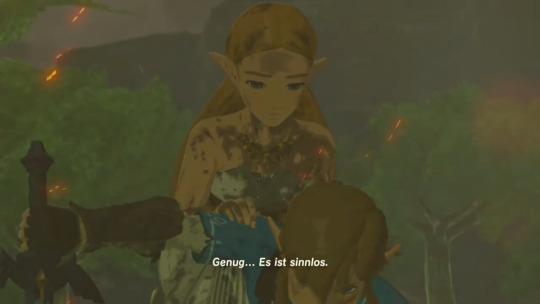
Translation: Enough... It is useless.
English Localization: Link, save yourself! Go!
As a Zelink shipper, I actually really love the English version of this line, where Zelda tells Link to not die for her. However, as a writer, I prefer the German version. See, in the English version of the game, Zelda strikes me as almost blind to the reality of the situation. Meanwhile, in German, she is desperate because the situation is, quite frankly, hopeless - note how she even states that it's useless (to fight) here. I'm going to come back to this later, so keep it in mind. For now, let's move on.

Translation: I beg you... You mustn't die too...
English Localization: I'll be fine! Don't worry about me!
Zelda uses the expression auch noch here, which technically means too. However, it implies something happening on top of everything else, in this case, after everyone else has already died. This also serves as a transition from the previous memory, in which Zelda states (in German) that everyone is dead because of her.
Again, my Zelink heart loves the English version, but I think the German version has its own appeal. Considering that Zelda blames herself for the deaths of the four Champions, and that she doesn't want Link to die too might not sound Zelink-y at first, but consider for a second. The Champions were Zelda's friends, and one of them was her mother figure. Her father is also dead. She pretty much has only Link left at this point - and we can guess from the other memories (as this is the final once you find in the game) that even though they had a rough start, he is extremely important to her. Even though it's not as explicit as in English, I think it's still a really nice moment that shows how important he has become to her, as more than just a bodyguard.

Translation: Run away!
English Localization: Run!
I really like the contrast between the scene in which Link protects Zelda from the Yiga, and this scene. There are some obvious parallels, only that in this scene, Link is too severely injured to save Zelda anymore (and in the end, she saves him instead). He tries his best though. I very much appreciate the effort that was put into his expression in this entire scene!

Translation: No!!!
English Localization: No!
... Three exclaimation marks, guys. Three. Exclaimation. Marks.
Okay, but seriously, I kind of love his moment where Zelda throws herself inbetween Link and the Guardian. It contrasts nicely with how Link protects her from the Yiga earlier in the game's backstory, and also with how he tries to defend her (even though he's gravely injured) in this scene.

Translation: Was... Was that me...?
English Localization: Was... Was that...
I really love that Zelda's Lullaby is sung by a choir after she purifies the Guardians. Also, the fact that she is shot from bottom view here, which makes her look greater, and also reminds me personally of the Goddess Statues a bit. All of this invokes awe, and really conveys that something very powerful and important has just happened.
On the localization note, I like that Zelda specificalls asks if she herself just did that in German. After blaming herself for pretty much everything that went wrong throughout the entire backstory and feeling useless, this is a very important moment for her, and the German localization makes it about her, both as the wielder of the sacred power to seal the darkness, and Zelda as a person.
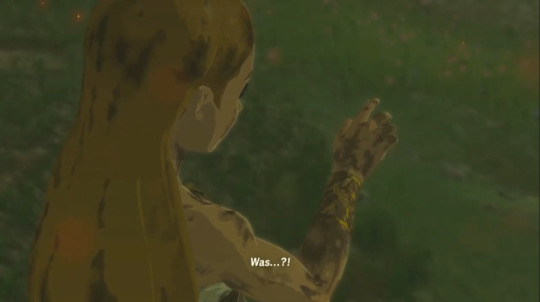
Translation: What...?!
English Localization: The power...
I like that we get a shot of the back of Zelda's hand too, showing that the triforce that appeared earlier has disappeared again.
I like that Zelda is more stunned and confused as to what just happens in the German version. In English, she seems to know what's up right away, but I actually like that she seemingly needs some time to process (which she won't get unfortunately - someone give this girl a break!) what just happened. Really helps reinforce the gravity of this event!
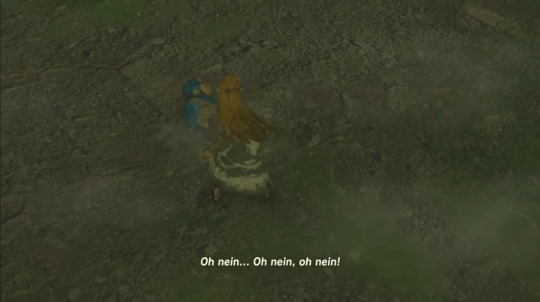
Translation: Oh no... Oh no, oh no!
English Localization: No, no...
Despite the fact that she would need time to process what just happens, Zelda immediately looks after Link when he collapses 🥺 If that doesn't show you how much she cares about him at this point, I don't know what does.
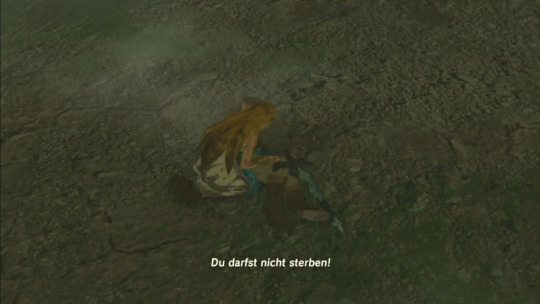
Translation: You can't die!
English Localization: Link! Get up!
Zelda uses the same phrasing (darfst nicht) as before, but this time, it's much much desperate. While before, she was trying to get Link to run, she is scared for his life now. Before, she used the phrase more in a sense of "if you keep going, you're going to die like everyone else, and you must not do that" in an attempt to get Link to run. Here she is using it more like "this can't be happening", desperate and unwilling to accept Link's impending death.
Julia Casper's (Zelda's German VA) voice acting is also phenomenal here. You can hear a little sob when she says this line, and it really conveys her despair.

Translation: Please, don't die...
English localization: You're going to be just fine...
Again, same phrasing as before, only that this time Zelda is explicitly begging Link not to die in the German line. I think it's both impressive and authentic that they used the same line three times, but each time with a different connotation. Zelda is completely exhausted and stressed in this scene, so she wouldn't have time or energy to think about how she expresses everything she wants to, so she just repeats the same core thought over and over: she doesn't want Link to die.
In the English version, she seemingly tries to calm Link instead. While on its own, I do like this line (especially as a Zelink shipper!), I do not like it in the context of this scene.
Remember how I said I was going to come back to Zelda seemingly not understanding the severety of the situation or being in denial about it earlier? Yeah, this is where the scene becomes... Weird to me in English. See, we never see her realize that actually, things do not look well, and no matter if you're going with the not understanding interpretation or the denial one, this causes a break in the narrative for me. Her view on their situation seems to change in-between lines, without an actual indicator of the change. It very much comes off as unnatural to me, especially with what happens next.
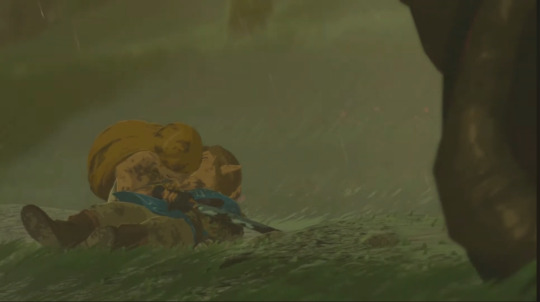
No text here, just sobbing. I wanted to note this because Julia Casper's voice acting in this particular bit of the scene sounds like she is actually crying. You can hear her sob and whimper (the really quiet one she does right after Link falls unconscious always gets me the most), and it's absolutely heartbreaking. It actually had me cry too every time I saw this scene in my playthroughs of Breath of the Wild.

Translation: There... Is still hope?!
English Localization: The sword...
Julia Casper makes this line (and the next one) sound like Zelda is still processing things once more, and I think it is very fitting.
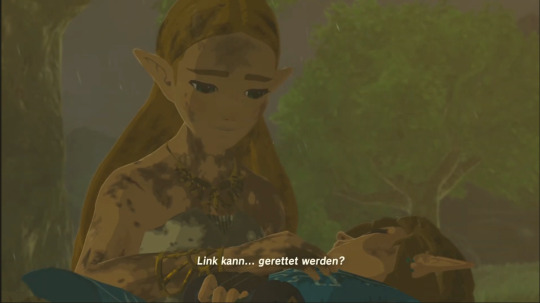
Translation: Link can... Be saved?
English Translation: So he can... He can still be saved?
I do like how this line and the previous one feel completely different in German and in English contentwise.
While the implication in English seems to be - at least in my opinion - that Zelda sees that the sword is still glowing, and comes to the conclusion that Link can still be saved by herself.
Meanwhile, in German the implication seems to be more that the sword tells her that Link can be saved, and she somewhat confirms this in her conversation with the Great Deku Tree later.
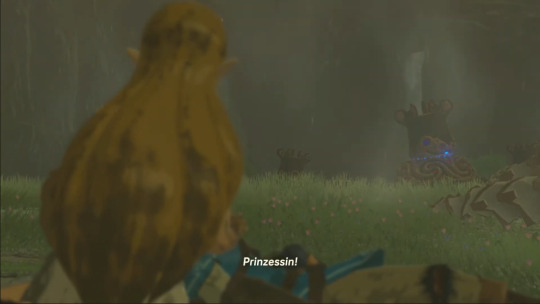
Translation: Princess!
English Localization: Princess!
... I do not like this line. It sounds like they're playing hide and seek, not like they just found the princess who has probably gone missing in all the chaos and who probably a lot of people were worried for. In both German and English (it actually does sound a little bit better in English IMO). Kinda disturbs the scene a bit.
I do like that they actually have Zelda gasp in response to this though.
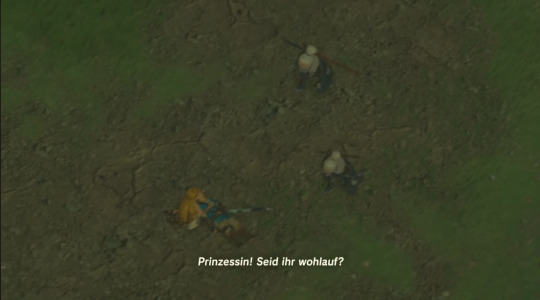
Translation: Princess! Are you alright?
English Localization: Princess! Are you all right?
Yeah, that line is better.
Also, look, Zelda still has her hand on Link's chest 🥺
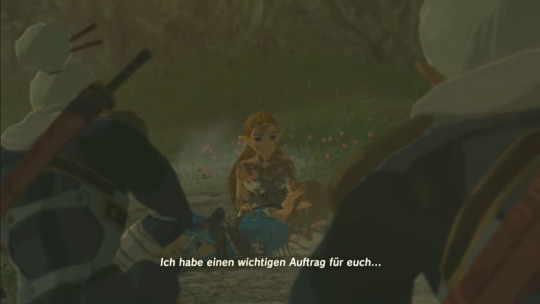
Translation: I have an important mission for you!
English Localization: Take Link to the Shrine of Resurrection!
Zelda sounds suddenly really confident and serious with this line in both languages. My guess is that it's because she knows that if she doesn't act, then Link will die, but also because she has trouble opening up. We learn this from her diary, and we know from both that and from other memories that she feels comfortable to show her true feelings and worries around Link (who is unconscious).

Translation: Take this man to the Shrine of Life as fast as possible!
English Localization: If you don't get him there immediately, we are going to lose him forever!
The Shrine of Ressurrection is called the Shrine of Life in German, possibly because the localizers thought that Schrein der Wiederbelebung or Schrein der Auferstehung sounds too complicated or too much like Link is a zombie now.
Also, Zelda calls Link a man in the German dub at this point, which actually caught me by surprise when I first played the game since Link just looks so young. I guess it's a reminder that they are already around 17 in this game, and that Link is a full-fledged knight. I also think it shows respect for Link on Zelda's part.
I actually prefer the German version of this line, simply because I think it works better in tandem with the shot we're shown. The delivery of the English line is great too though (and I say this as someone who usually doesn't like Zelda's English voiceacting that much).
Also, look how Zelda is supporting Link's head 🥺

Translation: Hurry!
English Localization: Is that clear?
Two different lines here, but I think both work. I also like that we get to see the reaction of the two Sheikah guys.

Translation: Before his light of life...
English Localization: So make haste and go!
Lebenslicht (Light of Life) is a more poetic way to say someone's life in German. It's not the same as light of someone's life.
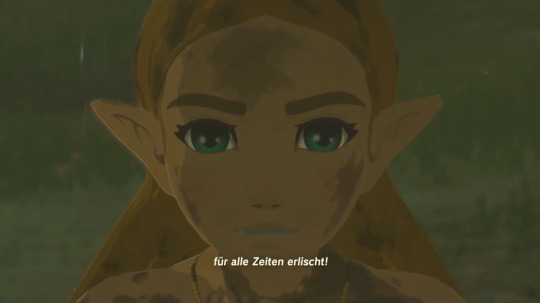
Translation: ... goes out for all times!
English Localization: His life is now in your hands!
Using the plural of the word time like this is actually quite common (even though using the singular wouldn't be incorrect), and I will admit that I have never really thought about why we do this before. I think in this particular case, it might be to emphasize the gravity of the situation, but this might be interesting to look into in general.
That being said, I actually prefer the English line over the German one here. I think it just provides the better ending to an overall very grave, very serious scene, that's pretty much the direct leadup to Link waking up at the beginning of the game.
In general, I think this is definitely one of the most impactful scenes in Breath of the Wild, and both the English and the German version do a great job at conveying this. The camera also works with the localizations (more or less) to improve its impact. Overall, analyzing it was very interesting.
What are your thoughts on this scene? Tell me in the comments, reblogs or tags if you want to 🙂 Thank you for reading!
#Meta#Zelda#Link#Zelink#Analysis#The Legend of Zelda#LoZ#LoZ Meta#LoZ Analysis#Breath of the Wild#BotW#BotW Meta#BotW Analysis#Localization#English#German#BotW Localization#LoZ Localization#Zelda's Awakening#Currantlee here#Currantlee translating#Currantlee analyzing
56 notes
·
View notes
Text
BOTW!Zelda’s powers dwindling after sealing Calamity Ganon is actually a fantastic conclusion to her character arc. She has finally been released from a role she was forced to fulfill but never wanted. We see throughout the whole story that her true passion isn’t magical but science. That traditional white dress represented a cage of expectations placed upon her and, in the end, she’s finally free of it.
To think a story managed to make a main lead that’s a girl losing her powers satisfying…
10 notes
·
View notes
Text
Idea: The Adult and Downfall timelines combined before Adventure of Link.
Hear me out: So I’ve seen the theory that the south western third of world map in Adventure of Link could possibly be an older version of the Akkala and Eldin regions of Breath of the Wild. The biggest evidence to this being that Death Mountain is in the south west here, where as in most zelda maps is usually in the north east of hyrule.
But this begs the question “where then is the rest of AoL’s Hyrule?”
Well, if you go back to BotW’s map, you’ll see that across the chasm at the edge of the north map, there’s the elevated plateaus of foreign lands. So elevated in fact, that, if Hyrule were to be entirely flooded, those lands would be largely untouched.  
So my theory, that the kingdom of Hyrule in Adventure of Link is the same kingdom as New Hyrule in Spirit Tracks but centuries later. The very lands that Tetra and the Hero of Winds had founded after Wind Waker.
Meaning that some time after the events of Spirit Tracks but before the sleeping princess Zelda of Adventure of Link was cursed, the worlds of the downfall timeline and adult timeline combined. Considering the amount of lost history in AoL’s time, it wouldn’t be surprising if a collision of conflicting timelines was the cause.
Ganon’s existence also confirms the combining as we know that Ganondorf the man had been killed at the end of Wind Waker in the adult timeline. while Ganon the monster kept coming back like a cockroach in the downfall timeline, despite the Hero of Legends many efforts.
As for what becomes of the joined timeline after Adventure of Link, my theory is that a combination of the oceans receding and the growing scarcity of resources in the land would motivate the people of hyrule to migrate back to the old lands once again.
Then after this, the joined timeline and the child timeline finally combine, thus ending what would be called “The era of Myth”. A name that was chosen largely due to all the confusing timeline conflicts that historians couldn’t possibly untangle, and so they chalked it all up to being a bunch of myths and legends. Some time after this we would get the sheikah technological revolution, and with it the events of Breath of the Wild’s the ancient hero.
#legend of Zelda#breath of the wild#tears of the kingdom#adventure of link#spirit tracks#wind waker#link#my babbling#botw meta#wild#hyrule#wind
20 notes
·
View notes
Text
If botw had made Zelda a spirit in the end, and she goes away with the rest of the champions leaving Link alone for good, story-wise that would have been amazing. It would have wrapped up the themes found throughout botw perfectly. Like top-notch heartbreaking storytelling
But on the other hand, if I think about that happening it CRUSHES me. Like full-stop, no way, 404 error, impossible. Cannot think about.
10 notes
·
View notes
Note
Something I noticed is that the main control panels for the divine beasts kinda look like the fairy fountains when the fountains are closed up . Which is neat .
Also fuck Ganon for making me deal with heights. Medoh flys so very high and it makes me anxious. But I've made it to the boss area , so that's something.
Also , I've heard there is a certain music that plays, I'm not sure but I think it's the the song that plays when you fight the blights, but it has a distress signal in it . And I've heard that it's theorized to be the champions sending out a destress signal before they were killed by the blights. And apparently Ravali's signal turned off in the middle for a long time , then comes back in the end. And there is one reason for this that fucking kills me. Ravali may have intentionally turned his distress signal off so the other champions get help first, only turning it back on when he realizes that the others have probably already died and he would very much like some help now. But help can't get there in time.
y'know, i hadnt noticed that! the blue fire furnaces look kinda similar too, i wonder if that says something about the origins of their not-electricity electrical power. maybe its a fairy thing!
*coughs in loves heights and definitely didnt try to jump off medoh to see what would happen*
yeah the sos beeps!! theres so so many tiny little heartbreaking details in this game, so help me--i hadnt heard about revali's having a break in the middle, that fits his overconfident and sassy exterior ultimately just wanting to do the best he could interior to a T :'( the champions deserved better, man--they died honorably and they fought bravely but all of them were too young and in too hopeless of a battle.
#asks#bliz rambles#botw#maddymayhearts#liveblogging my mutual's adventure through the beautiful chaos gremlin game#botw meta
5 notes
·
View notes
Text
obscure kin memories rly choose the most inconvenient times to surface huh
like, im really going through it with shit in the here & now, got a million things on my mind, but okay guess i'll play botw & see how many campfires i can successfully light around this hebra hot spring while im dissociating on the shitter,
oh damn it's been longer than i meant i should get out of here huh,
better brush my teeth though, those don't grow back unless mipha's around & it's from a sudden injury. gotta remember to tell prince sidon about the letter i wrote the king when i was 12 when i found out about that from granny & aryll made fun of me for 2 whole weeks.
hold on, wait, slow down. granny & aryll. this is new.
oh. mipha was aryll's friend first. that's how we met, since she was older, but aryll kinda "outgrew her". hand-me-down best friend. oh. granny & our mother were from lurelin. our father was from central hyrule & retired to the coast young from an injury.
no, stop, i said slow down???
this is a LOT??? i was just brushing my TEETH, come on???????? I DONT NEED TO CRY ABOUT MISSING FAMILY FROM ANOTHER LIFETIME NOW TOO????????
#kin talk#long post#uhhh#botw meta#i guess#idk im. sorry. i dont usually post this shit any more but this was just SO heavy im feeling. almost physically crushed rn.#vent#???#don't recycle#take a deep breath#my sweet serenity#comfy#oh i am so homesick it BURNS
5 notes
·
View notes
Text
a lot of people have already pointed out how totk has a lot of themes of imperialism and generally leans conservative ideologically, but what i think is interesting is how totk subtly redefines what a “researcher” is.
zelda wants to be a researcher in botw, and what this means in the context of botw is largely someone who works with sheikah technology. she wants to figure out ancient sheikah tech, she has an interest in botany and otherwise nature and biology (the whole silent princess and the frog thing), robbie and purah, the two characters who are the closest to us seeing what a researcher in the context of botw is are basically inventors. in totk, however, the main researchers who are presented to us are all historians.
this is an interesting pivot, because in botw zelda is not really interested in history. if anything, the one who’s deeply concerned with history is rhoam, wanting to preserve historical tradition and his uncritical reliance on said tradition and historical precedent is what leads them to their doom. in botw, zelda is narratively opposed to history, if anything, all the ancient tech backfires on them and traditions fail to awaken zelda’s power. zelda’s urge to be a researcher is in wanting to understand the world around her, not just blindly follow ancient plans but rather have agency within them.
totk, however, is obsessed with ancient plans. the only real moment where zelda gets to geek out in totk is her getting all giddy about finding out more about the divine origins of hyrule. all the researchers in the game are concerned with finding out more about the zonai. since all the mentions of ancient sheikah technology are scrubbed from the game purah and robbie read more as strange outliers, the sheikah slate is no longer, now it’s the purah pad, a product of purah rather than something larger. the whole game is literally about following an ancient plan, a plan most characters don’t fully understand as they sign up for it. totk’s main story is built on confusion, on the characters not knowing what’s fully going on but having faith in ancient sages telling them what to do. in botw, following ancient plans you don’t fully understand was the thing that doomed you. in totk, following ancient plans you don’t fully understand is the gimmick.
that juxtaposition between the two games has an ideological through line: botw posits that progress is necessary. mindlessly relying on tradition doesn’t work. prophecies are omens, not instructions. history must be learnt from, not repeated. the ancient sheikah aren’t a group to be emulated, but rather to be learnt from, considering their machinery backfired and the royal family betrayed them. totk, however, is obsessed with the mythical history of hyrule, a time where everything was idyllic until one bad man showed up, a time we must emulate in order to win. i already talked about how the past in totk is zelda’s life pre calamity but better here, but that also plays into the idolisation of that era and its royalty. in botw, even the myth of the first calamity preserves the fact that the yiga clan has origins in the royal’s family persecution of the sheikah, even the time when they successfully held back the calamity is tinged with mistakes that still affect the world ten thousand years later. in totk, ganondorf’s origins are nebulous. nobody provoked him, nobody did anything wrong, he’s just evil because he is.
a lot of right wing ideologies are hinged on preservation, but more than that: the belief in the nebulous mythical past in which everything was better. “make america great again”, the fascist’s idolisation of ancient rome which is represented largely inaccurately, look at any conservative rhetoric and you’ll see people complaining about how things nowadays are ruined or are being ruined, how in the past things were this way and they’re not anymore, which is bad. the belief in the fact that in some past period we were great and are not anymore, and the strive to emulate that past is a trait highly typical of right wing ideologies. and in totk the past as a great era is an idea presented completely uncritically, the narrative is entirely controlled by the game and doesn’t dwell on any of the inconsistencies in this idea.
now, obviously, not every story in which a great ancient era exists is fascist, right wing or conservative. but to me what’s interesting specifically in totk is this shift between the two games: botw is critical of the past. it’s critical of arrogantly repeating history, it’s critical of having blind faith in great relics of the past. totk isn’t. totk idolizes the past, totk tells legends and tells you to believe them without any doubts. botw believes researchers are those who seek to understand the world, innovate it and solve problems without relying on ancient ways. totk believes researchers are those who discover ancient instructions, ancient ways and relay them to great men in the present to be followed. the four mainline regional quests in botw are about discovering four ancient relics that are terrorising the land and fixing the mistakes of the past. the four mainline regional quests in totk are about discovering four ancient legends are true, and receiving instructions from an ancient sage on what to do.
totk is not simply neutral, it is ideologically conservative in stark contrast to botw, because of the things it chooses to leave uncriticised, notably the things botw was very poignant about examining critically. the way totk redefines what is a researcher is indicative of this, indicative of the way it chooses to idolize or present as an unexamined good that which was nuanced in botw. totk isn’t just conservative in the sense that it presents uncritically a “good king” and “evil conquerer”, it goes deeper, it’s notable because botw was starkly opposed to the thematic axioms totk presents.
i just think it’s very interesting that they made a sequel to botw, and completely redefined or otherwise ignored botw’s thematic core.
#totk critical#loz#botw#totk#legend of zelda#tears of the kingdom#breath of the wild#meta#analysis#my hot takes
2K notes
·
View notes
Text
I was watching a video analysing how the Yiga clan were handled in botw and how the person analysing it lamented the fact that Kohga was a joke character who totally destroyed the much more threatening image the yiga clan had all throughout the game. Although I do understand the sentiment (I felt that way for a long time) I’ve come to realise that we might not be viewing it in the right perspective. I ended up writing a comment under that video explaining how I saw things, and realised that maybe it could interest people here too? So here is the fleshed out version of it:
I think part of why they made Kohga extremely goofy compared to a way less goofy clan of literal assassins is to emphasise how even though the clan originally held some understandable beliefs, it has become a cult of personality over the years, and like most cults, the leader is way less charismatic than his followers make him out to be. Indeed, from the outside, it seems absurd how anyone could take Kohga seriously, let alone kill under his command, but from the inside, Kohga is the Beloved Leader That Guides Them Towards Victory, and anyone threatening him deserves to die.
In a way, yiga clan members feel like vulnerable, impressionable people who were enrolled into a cult and given a Big Family and a purpose (and a lethal weapon) by their lovable Master Kohga who wants the best for them… Except if you want to get out, then you’re a filthy traitor who also deserves to die. It’s especially visible when you beat him and they all get personally mad at you for killing him. They didn’t care about Ganon, they didn’t seem to actually understand the bigger picture, they only cared about Kohga.
It also shows how, like the rest of Hyrule, the Yigas are very much disconnected from their own history, seemingly holding on the grudge their ancestors held more as an excuse to continue to enact violence and perpetuate the cult of personality than fighting for a “noble” cause. Only Kohga seems to actually care about Calamity Ganon, and the rest of the yigas seem to be just tools to him. Wether or not he’s actually conscious of what he’s doing is unclear. Is he a fully aware con artist, or is he purely another product of Yiga indoctrination?
So yeah, to me it feels like a parody/critic/mockery of cult dynamics. It shows that this gang of assassins are indeed a real menace, but for seemingly no reason other than “that one lunatic they admire told them to” and “if they go away they get killed”. The reason why the clan was originally created becomes almost anecdotal. Under the current leader, no one is required to actually know what they’re doing, they just need to follow orders.
In the end, I think it is the intention the developers had because cults are a rampant problem in Japan. At the very least, even if it’s not a actually conscious critic, it’s a concept that is much more present in their cultural landscape than ours and that almost certainly influenced how they handled the Yiga clan. Basically, cults are not cool and can even be dangerous both for the public and their members. Cult leaders especially are not cool and often are con artists. Therefore, Kohga couldn’t be badass, he had to be a doofus getting beaten in the most unexceptional way possible.
#botw#breath of the wild#master kohga#yiga clan#kohga#loz#the legend of Zelda#tloz#meta analysis#i purposefully didn’t talk about kohga’s change of heart in AoC because to me this game is not canon#one could argue it proves that Kohga is actually not aware of how catastrophic enabling Ganon would be#but for the sake of keeping it focused on botw I didn’t mention it#cult mention#valictini talks
2K notes
·
View notes
Text
THE GERUDO POST
(aka an attempt at a critique of how gerudos were handled in BotW and before)

Oh no. TOTK being right around the corner, it might finally be time for the Gerudo Post.
(aka half of the reason why I made a Zelda sideblog in the first place)
So I want to preface all of this by saying that, as you could probably tell already, I’ve always adored the gerudos. They have fascinated my small child brain when I was 7; then the obsession made its comeback when I was 14, and now, here we are, almost 28, and I’m still thinking about the gerudos. I think they might be among my favorite fictional cultures for their potential and their understated storyline. I guess growing up in a very Arabic neighborhood, coupled with being bi-culturally latinx (?? does Brazil count?? you tell me), also always made them feel like home to me –especially when I was very young and there was not a lot of cool female representation flying around that managed to involve fiercely independent PoC women, flaws and teeth included.
This whole weird-essay-thing tries to do two things. First: analyze the place gerudos have occupied in the series, their initial problematisms and their subtextual narrative arc during the Myth Era coupled with their relationship to Ganondorf. Second: tiptoe to Breath of the Wild and poke it with a stick to see what happens –and in doing that, explain why I believe a lot of their characterization was defanged in service of smoothing their past with the hylians instead of deepening the culture on its own terms, and why I’m a little apprehensive about what that might mean for TotK even though I adore seeing the best girls at it again.
Those are the uhh terms of service??
And now, we must go back to 1998.
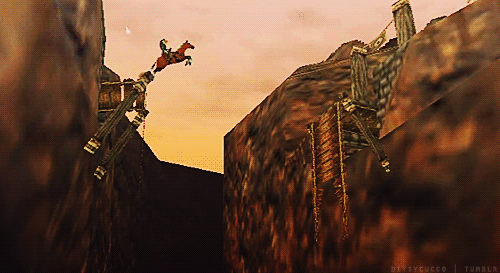
OCARINA OF TIME ERA
There’s so many things about the gerudos that are noteworthy and rich, and they’ve made for a complex piece of Zelda lore ever since their introduction –and when I say complex, I don’t 100% mean it as praise. The very racially charged decisions made about their inclusion have been discussed at length by the fandom, especially when it comes to orientalist and Islamophobic tropes being deployed pretty thoughtlessly in Ocarina of Time (their sigil being literally a crescent moon and star originally, the parallels are pretty obviously there).
We’re talking about a band of amazon-like, big-nosed brown women from the desert ruled by a single Scary Evil Man born once every hundred years hellbent on conquering Hyrule who they apparently worship like a god, characterized primarily as thieves, decked in jewelry and orientalist-inspired harem/belly-dancing clothing, hostile to the white good guys of Hyrule (especially men), unblessed by the Goddesses and so deprived of elongated ears (this is true for OoT –we’ll come back to that), also known as a demon tribe with their deity straight-out described as evil-looking by Navi (on my way to cancel you on twitter Navi you watch out), and secretly led by evil twin witches who can turn into a single seductress and, as two mothers, raised their Scary Evil Guy king who happens to basically be the devil.
In so few words, gerudos are the future that liberals want.

It’s worth notice, also, that Ganondorf’s characterization in this game is… kind of relentlessly uncomfortable to play through, especially before the 7 year skip. The utter assumption of depraved and evil intents from every character surrounded by dialogue that does little to hide its biases in spite of having generally very little proof to back them up –even though, in the game’s context, every character is correct to call his eyes evil and the darkness of his skin a moral judgment in on itself. The scene where Zelda demands that we believe her conclusion that the sole and only brown guy in the entire kingdom is evil and will do harm, and the game straight out refuses to progress until we concede that her dreams are prophetic and that this man must be stopped at any cost even though she has no more proof than her discomfort… hits different on replay.
I’m restating all of this not to pretend I’m making a novel and thought-provoking point, but to bounce back on a tumblr post I saw a while back (that I can’t find anymore!! I’ll link it if I find it again) –and so express what it is that gripped me with the gerudos in spite of their pretty damning depiction… and actually maybe thanks to it.
There’s a surprising amount of texture to Ocarina of Time’s worldbuilding that exists folded within the things introduced and left hanging, or in its subtext –and whether on purpose or not, I believe it is why people keep coming back to this iteration of Hyrule.
What was that about the king of Hyrule unifying a war-torn country? Why did the gerudos break the bridge connecting them to the rest of the kingdom during the 7 year timeskip while still worshiping Ganondorf, and why are the carpenters trying to rebuild it against their apparent wishes? What was that about gerudos imprisoning hylian men trying to force entry into their lands? What was that about the secret death torture chambers right next to the Royal Family’s tomb and connected to the race of people who were, apparently, born to serve them?
Nothing? Oh okay… okay… okay….
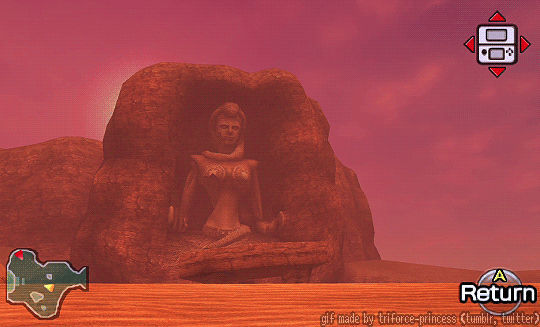
The same can be said about this strange depiction of this hostile tribe, consistently described as wicked yet suddenly friendly once you prove you deserve their respect once you... defeat them, so you now have joined them? Ocarina of Time isn’t very consistent when it comes to characterizing them as their occupation (thieves) or as a proper culture, with a king and a strange system of rulership that seem to involve at least 5 people: Ganondorf, the Twinrova, Nabooru and the unnamed random woman who decides you’re now part of the gerudos because you slashed enough of them with your sword and hookshot, which, uhh ok.
They’re but a ragtag and negligible group when discussed next to gorons and zoras and hylians, but they also clearly have their own religion and at least a 400-hundred years old history (probably far longer than this) and hints of a written language of their own. I’m not sure the game itself knows what it wants them to be, beyond: intimidating and hot and cool, but also wicked and, because of Ganondorf and the way you barge in their forbidden fortress (heh) with the explicit intent to dismantle their king, in apparent need to be saved from themselves.
Speaking of rulership and the Spirit Temple, let’s have a quick tangent about Nabooru: I always found her characterization when meeting with Child Link pretty strange. I refuse to mention the promised reward, which feeds into everything orientalist mentioned above, but I always found her moral compass so extremely convoluted for someone coming from gerudo culture. Nabooru says that, despite being a cool thief herself, she resents Ganondorf for killing people as well as stealing from women and children. Stealing... from women. Nabooru. Why are you this pressed that he steals from women!!! This feels so out of place, that the only girl of that hostile culture that betrays her king and befriends you, is the one that upholds moral values that only a hylian could possibly hold.
Either way: the strange unquestioned contempt of the game for them as a culture, mixed with the occasional bouts of heart, friendliness and badassery, makes it hard not to consider their depiction as pretty biased in favor of the hylians finding them at once exotic, scary and exciting, and could hide a more complex reality you might only get one side of –especially when you know there were originally plans for Ganondorf’s character to be more gray and motivated than what the campy final version ended up being. To be blunt: even in the context of a game for children, and maybe because of that fact, it all reads like a reductionist and imperialist/colonialist reading of a more complex situation.
This might seem like A Lot coming from a game where the actual game writing can be this overall flimsy and simplistic due to the standards of the time (it’s rough, it's so rough). But I would have never dwelt on that thought about a little children’s game if not for the mainline entries that came soon after, because... ooo boy.
The sense you’re not getting the whole story was certainly not helped by the introduction of Wind Waker Ganondorf, and the chilling emptiness of Gerudo Desert in Twilight Princess.

AFTER THE TIMELINE SPLIT
(I’m skipping Majora’s Mask, not because I dislike them in the game or think they’re not worth talking about, but because it’s a parallel universe and they’re never even called gerudos and their reality seems extremely different from their sisters in Hyrule so I think it’s okay to call them tangential and not dive too deep in this particular depiction)
Here’s something I want to highlight about gerudos and how they were characterized before BotW came along: their absence. Not only their physical absence, the lack of any gerudo character that calls themselves gerudo, but their absence from the text itself.
It’s not that Wind Waker and Twilight Princess retroactively scratch them off existence: we can clearly see Nabooru’s stained glass art in WW as well as recognize them being mentioned in Ganondorf’s final boss soliloquy, and WELL there’s quite a lot to say about their imprint over the world of TP. They are there –or at least they... were there. But nobody ever talks about what happened.
In Wind Waker, there was the deluge. It’s assumed lots of people died then, and those who survived scattered across the Great Sea. Are they sealed under the waves? Have they drowned? Is Jolene, Linebeck’s ex-girlfriend in Phantom Hourglass, a distant relative of one of the rare survivors? It’s unclear, beyond the fact that Ganondorf is the only living gerudo we see in this entire branch of the Timeline split.
In Twilight Princess, the desert which bares their name is empty. The hylians never mention that it used to be the name of a tribe: they’re not even named when Ganondorf is introduced for the first time, reduced once again to a mere band of thieves. We learn his plans to steal the Triforce in OoT were foiled, and that he may have turned to war. Then he lost the war, and was executed in Arbiter’s Ground: a strange structure in the desert, a mixture between a temple, a prison and a coliseum. What looks like gerudo writing coexists with hylian symbols, which often look much fresher. This dungeon is the Shadow Temple of TP: a prison hosting the worst criminals the kingdom has ever known, now haunted and cursed. Besides the locations, the only character that vaguely look gerudo in the entire game besides Ganondorf is Telma, a character with pointed ears that never seems to identify as anything but a hylian. What happened? Who’s to say. Nobody ever says anything. Not even Ganondorf bothers to mention them the way he did in WW –and though the game’s story is quite focused on another exiled tribe seeking revenge and dominion over Hyrule as retribution, the parallel is never explicitly drawn. So who’s to say what happened there. Who’s to say.
And in A Link to the Past and the games forward? The only mention of other gerudo characters are Koume and Kotake, resurrecting their son in the Oracles games through their own sacrifice and failing to bring anything back but a monstrosity incapable of making conscious decisions. Granted, most games in that extremely weird Fallen Timeline predate OoT and therefore had yet to make gerudos up at all. Still: canonically, between the gap of OoT and ALLTP, whatever it may be, gerudos disappeared here as well.
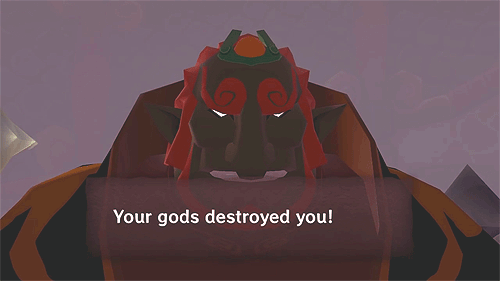
I think there’s something subtle and a little heartbreaking about the fact that no matter what Ganondorf does, the gerudos always end up dying out. His yearning for Hyrule, its gentler wind and the Triforce blessing its lands always costs him the kingdom that he does have already.
Now, does he care? A lot of people would argue that he doesn’t, that he used them like pawns for his own ambition and saw them as servants more-so than sisters, and I wouldn’t be surprised if it was Nintendo’s official opinion, but… One very powerful thing about most of Ganondorf’s incarnations (focusing on the human ones) is that he never seems to reject his cultural heritage. They could have gone for him wearing more kingly hylian stuff given the whole underlying theme of envy and pride surrounding his character, but never once does he try to look more hylian, beyond the ear situation that seems to be tied to the Triforce of Power? Either way: he is gerudo. Several of his outfits reference his mothers, as well as general gerudo patterning and jewelry. His heritage is something he proudly displays, even hundred of years in the future when there is no one left to remember what it means but him. I think it’s a very potent piece of characterization, an arc that crosses over multiple game and says something pretty intense about this character’s fate and his inherent destructiveness over the things he touches –starting with the Triforce, all the way up to his very own body and mind. His mental breakdown by the end of Wind Waker, when the king of Hyrule himself forces him to give up on the thing he sacrificed everything for, takes a new kind of weight with the whole picture taken into account.
(not to excuse genocide or general egomania-fueled madness and violence, but one thing doesn’t mean the other isn’t also relevant)

Regardless of whether this is a tragedy for Ganondorf as their uhh complete failure of a king, honestly, it is undeniably a tragedy for the gerudos themselves: a once-in-a-lifetime joyful event turned into a never-ending nightmare from which there seems to be no escape, their legacy now condemned to fade to black, leaving nothing behind but a demon boar forever laying ruin upon the world.
One may say I’m taking on the bleakest explication for the gerudos’ absence when there could be others. It’s true! Perhaps the gerudos are just chilling off-screen, completely fine, not interested in whatever is happening in the kingdom nearby and their disaster child having yet another temper tantrum about not being the Goddesses’ favorite boy. It’s possible! But regardless, what little elements we do possess as players doesn’t seem to support this, even if it remains possible –and regardless of actual gerudo lives, gerudo culture is definitively a goner in every single timeline.
Even if they did survive... Hyrule still won its unification war.
(I won’t mention Skyward Sword as they are not really a thing there, except for a butterfly that seems to suggest the Gerudo Province was a thing before the gerudo people –I don’t know what to do with this honestly– and the whole Groose situation, which, I’m not sure what to make of either beyond the fact that he may have gotten cursed by opposing Demise? And then went on to start the gerudo tribe, which ended up being an all-women group for some reason? Maybe? It’s not confirmed? I feel like it’s more of a fun tidbit than a central piece of the gerudo puzzle, so I’ll leave it there like I would a cool rock I brought back from a walk and that I don’t know where to put in my house)
Then, Breath of the Wild happened and changed things.
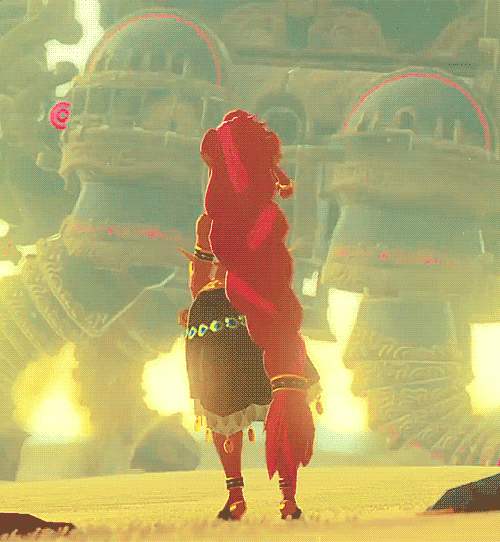
BREATH OF THE WILD
(Additional short note, but: while I won’t mention Four Swords Adventure, since it’s a weird one that almost nobody has played and severely messes with the Timeline, we kind of see the beginnings of what is about to happen in Breath of the Wild in this game –gerudos coming back without much explanation, then distancing themselves from Ganondorf to become friends with hylians because he was too hungry for power and now they are nice and have good reputation because they are our friendsss)
I was actually so happy to learn gerudos were making a comeback in a mainline Zelda game, and this got me more excited about Breath of the Wild than basically anything else the game involved. And getting to explore the Desert once again, meeting this new batch of impossibly tall buff girls, getting more about their language and their culture, Riju and the rest of the little girls are adorable, the grandmas are so cool, the sand seals??? sign me the fuck up??? And above it all, hanging around Gerudo Town at night and feeling as warm and cozy as little me liked to imagine how freeing it would feel, to stay there and watch the desert behind the safety of their walls in OoT… This was great. I loved it.
It was a huge compensation for the criticism I’m about to make, but did leave me with… questions regarding how their culture was going to be handled moving forward.
I’ll start with something small yet deeply revelatory, then work my way from there.
So... gerudos’ ears are pointy now.
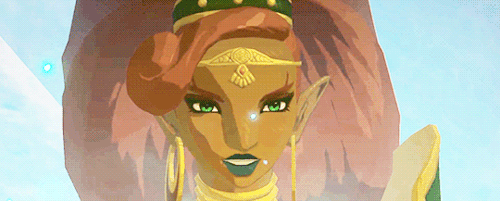
This is pretty significant. Lore-wise, it’s been said that the elongated ears of hylians are there so they can better hear the voices of the gods. It’s considered a sign of holiness in-universe. There's a bunch of really thoughtful analysis on tumblr over that whole Ganondorf ear situation, which is a mess but also very interesting, but the short answer is: I think the absence of pointy ears was a clear design choice to originally signify them as Less Good. Even when Ganondorf gets pointier ears, they never get as long as hylians’. Worth noting: not every non-gerudo character has pointy ears: gorons, zoras and ritos (among others) do not possess this trait, and there are even some humans that have regular rounded ears in the series –though they always seem to be of lesser relevance, if not downright peasants in Twilight Princess. Pointy ears always tended to implied a strict hierarchy in the series: basically, the more pointy, the more Protagonist you become.
(also their eyes becoming green instead of the traditional yellow/golden, which looks more wicked and demonic --and cooler also tbh)
The pointy ears imply two things. From within the game, this could be interpreted in two ways: either that gerudos… converted, for a lack of a better term, and are now considered holy through their worship of the Golden Goddesses and/or Hylia, or that their mingling with hylians through tens of thousands of years had them acquiring this trait out of sheer genetic override (though they have kept their mostly-women birth rates, their big nose, darker skin –for the most part– and red hair). Probably a healthy mixture of both. Design-wise, it signifies something quite simple to the player: they are on hylians’ side now. They are good guys. We can trust them, even if they still have a little spice in them. They aligned themselves with us and against Ganon in all of its manifestations (even if he’s but an angry ghastly pig being parasitic to everything it touches in this iteration). They are on the side of Good, definitively, and will fight evil by our side.
On that note, I think it’s worth bringing out another major change from their initial iteration, which is their overt friendship with Hyrule as a whole, and with the Royal Family in particular. Despite not allowing any voe inside their walls (we’ll come back to this), their relationship with hylians is pretty neat. They have booming trade roads, travel and meet with the rest of the cultures, and are fierce enemies with the Yiga clan, who are renowned for being huge Calamity Ganon supporters. The tables certainly have turned. I want to bring out, in particular, Urbosa’s friendship with the queen and her role as the cool aunt taking care of Zelda and protecting her from evil (to be noted: I am not familiar with Age of Calamity so if I’m mischaracterizing her in any way, please let me know). The gerudo sense of sisterhood has been extended to the royals they used to fight against. I would go on and say the cultures peacefully coexist, but I think that what we’re looking at here is a case of vassal behavior, just like we used to have from zoras (in the non-Fallen Timelines) and gorons. This is a huge departure from gerudos being openly rejecting of Hylian culture in their initial iteration, and something that is worth returning to later.

Okay. Now it’s time to mention the weird obsession BotW gerudos have with romance. I didn’t take notice of my issues with their writing until I realized how prevalent of a theme that was. Now, the reason given for gerudos to refuse entry to males (of every race) has much more to do with preventing young gerudos to make mistakes than anything else, and is actively being put into question by the younger generations –which would make sense. But the amount of NPCs that either lament their lack of match, talk about their husbands (because they marry now apparently) or are invested in romance, and a very limited understanding of romance at that (heterosexual, closed, etc), makes for much more of the population that I initially expected. There’s no mention of what’s going on with their males, if there are new males being born and either exiled or abandoned, or if Ganondorf being technically still alive have have cut them off male heirs. Either way: no more kings, only girlbosses chiefs.
To have the gerudos so interconnected with Hyrule, not only through trade but through extremely coded romance where they have to make themselves palatable to a future male partner and enforce fidelity, was… a choice. The extremely brief and skippable mention of gerudos sometimes going to Castle Town in search for boyfriends in OoT became half of their personality traits in this game. We went from a race that was fiercely independent and mocking of the unworthy men who tried to mingle with them, to… this. Now I’m not saying some of the sidequests aren’t cute, or that I didn’t like the wedding, or that the grandma near the abandoned statue of Hylia (so she was worshipped at some point) clocking us and talking about her love life wasn’t one of my favorite gerudo conversations. I’m saying that the vibes have definitively changed. For the better? I’m not sure.
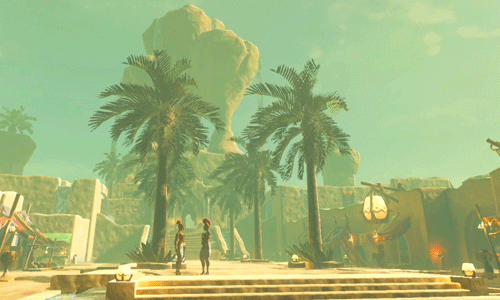
I once stumbled upon an article that said that Breath of the Wild gerudos were a huge improvement compared to their original introduction, because they were no longer presented as evil and hostile thieves groveling at the boot of a single man, but as a full culture allied with the protagonist and actively involved in the story, while still getting their Cool Girl Badass moment (again can’t find it anymore, I’ll link it if I stumble upon it again). I see where this comes from, but I honestly can’t help but consider it a reading that assumes something pretty major (though through no fault of their own, as the games tend to hammer this down as hard as they can), and that being hylians as the unquestioned anchor of Good.
Which, in spite of what the games want me to believe, I… feel uncomfortable taking at face value.
To me, regarding how gerudos are being incorporated in that goodie narrative, this is kind of a case of surface-level feminism trumping over colonialist/imperialist concerns. It becomes more important to perform the aesthetics of being cool and friendly and independent than scratching at any deeper problem that would risk making people uncomfortable. This is kind of Green Skin Ganon all over again: oh wait, isn’t it a little icky to have the evil bad guy being brown while faced by the most aryan-looking ass heroes of all time? Okay, then let’s take the brown guy and make his skin green so we don’t have to feel bad anymore that the conflict has racial undertones!! Solved!! There’s nothing questionable about changing a PoC's features to make it more monstrous and less human, right?
To me, it’s kind of the coward option: instead of accepting the messy reality those initial choices created (and their interesting nuances if taken at face value), let’s just… rewrite the PoC culture’s history to make it feel less uncomfortable for the white heroes. In many ways, it is an extension of what hylians have always done: scrubbing the weird and messy things about the past and shoving them deep down into the spooky well and far into the desert prison and away in alternate hellish dimensions, and then make up a very simple story where they get to feel good about themselves –except this time, it’s the fabric of the games, the literal reality, bending backward to make it happen. Which, in my opinion, makes it much worse than before. Now, there’s no conversation. The fabric of reality is changing their own history so that there is nothing to discuss anymore. Ganondorf was always evil incarnate. He never had any point. It was always 100% his own fault, his own hubris, his own fated wickedness. He was always demonic (and green, very important –having a flashback to people on twitter accusing artists restoring the TotK green skin to the original brown of wanting to make Ganondorf black, and like….. how do I put it gently…..)
And, above all else: gerudo are to distance themselves from his legacy so they can stay in the club of the Good and Just and Holy.
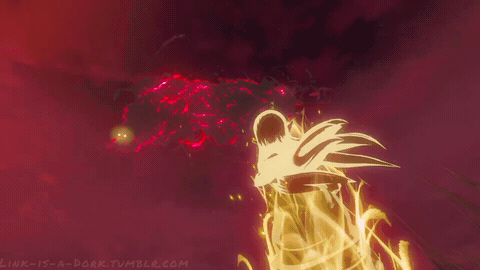
Because here’s the messy thing: as much as I love seeing the gerudos again in Breath of the Wild and as much I love for them to have survived the Era of Myth (??? somehow ???), this… kind of changes Ganondorf’s character arc. No longer do we have the story of a king who wanted more, either for his people, for himself or both, and led his culture to its destruction in his search for absolute Power, while remaining ironically incapable of maintaining what little he already had. This starts from him kneeling to the king of Hyrule in OoT and leads to the deluge, Arbiter’s Ground, his own mothers dying for the sake of his failed resurrection. Breath of the Wild changes this: now, the gerudo were apparently fine without him? They apparently did their own thing and became suddenly and inexplicably disconnected from his actions? I know it’s kind of implied they side with hylians at the end of OoT, but it’s honestly never really explored why they would cheer for the death of their king while never seeming to resent him before except for Nabooru –there are mentions of brainwashing for those who resist him (as well as “other groups in the desert”, tho they are never mentioned again), but it’s hardly a proper plot point for the majority of the tribe, aaaand they still die by Wind Waker in the Adult Timeline, in spite of their potential alliegance…
(again, this shift towards submitting to Hyrule actually started with Four Swords Adventure, getting crisper with each iteration)
There used to be this polite blur regarding Ganondorf’s relationship to them, how much he used them and how much he acted in their name (with arguments for both sides), and I think this messy and debatable question mark was one of the most compelling aspects of his character. Gerudos rejecting their relationship at a near-cosmic, reality-bending level, removes a huge layer of complexity to both parties… all for the benefit of making hylians come out cleaner out of this whole exchange, their moral grayness barely a whisper in the distance.
I’ll kind of go on the record and say that I suspect the addition of Demise to the canon to serve a similar purpose (at least in part): if Ganondorf becomes but the manifestation of a demonic curse, and is no longer an extremely messy character brimming with agency and drive, forcing the heavens to reckon with said agency in a way he was never meant to access, born from a complex set of circumstances from which we clearly get only a limited and biased perspective, then it becomes extremely clear that he’s a Bad in a way that isn’t worth exploring further. Even if he does have some points, he is a Bad. It’s what matters most. Not to say I even hate what this angle can bring to the table or that I want him to become Good (I don’t –I’ll talk more about why I dislike most takes on him being a helpless victim to the curse), but once again, who benefits from adding another Unquestionned Baddie to the equation to rest upon? Not him, and not the gerudos, that’s for sure.
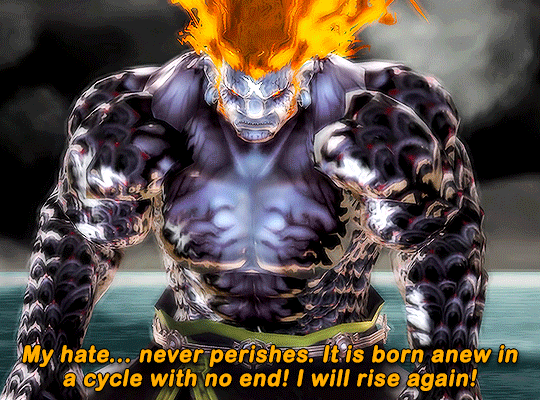
So. Why did I, me, personally, like the gerudos in the first place?
Beyond the inherent coolness factor of their culture and the fascinating mysteries of what is merely suggested, I think… I think I loved gerudos because we were obvious outsiders. Because their rejection of Hylian culture was so sharp and extreme, their value system so different, and their writing, their religion, their relationship to power and hierarchy and worth wanted nothing to do with hylians. They didn’t need hylians, beyond them having potential resources to steal. In fact, the threat of hylians influencing their culture was such that the entry to the Fortress was forbidden to everyone (I don’t think men were ever singled out, by the way, even though they are mocked relentlessly). I think there was something inherently hopeful about this semi-matriarchy resisting the outside world, and especially its notions of what girls were meant to be –it was 1998, and every other girl character in OoT, besides Impa and Sheik that?? is another can of worms entirely, is either helpless or someone to save. For them to reject this narrow vision of femininity was, in my opinion, much more radical than what we got in BotW. Less nuanced, more problematic perhaps? But also much more powerful. Gerudo Valley is home, not to a town, but a Fortress.
Hylians were worth being resisted.
In Breath of the Wild, their refusal to let men enter their town is kind of boiled down to a fading tradition over-focused on romance, a meek little game of chase. Their entire goal seems to be finding a hylian to settle down with. Say what you will about the single man and the many girls (never explored and completely open-ended in its implications, btw), but at least it wasn’t… that. At least it opened the way for different ways for people to exist and imagine culture and civilization, outside of the heterosexual couple, the christian-infused patriarchy and its trickling down implications. What I want to say is: let my girls tell hylians they ain’t shit!! That they aren’t the end all be all of reality! This is what made gerudos so compelling in the first place! Where is that bite now? Where is that self-definition?
It’s gone, because hylians need to be Good. So we tee-hee at the creep running laps around the town, we disguise ourselves to breach their trust and infiltrate their town (though there is nuance to be had there, gender be complicated etc), we watch them pine after shitty dudes and take classes to become the perfect approachable woman and make love soups with ?? strange ingredients honestly, and we witness them get very friendly with the Royal Family they used to conspire against, dying to protect the princess against the manifestation of their ancient king reduced to a raving puddle of Bad Boar.
Hyrule, unified against him.
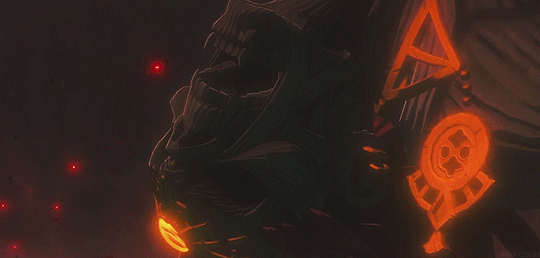
TEARS OF THE KINGDOM
For posterity’s sake: this post was made before the game was released. I’ll probably update my thoughts on a separate thing later on.
I don’t think gerudos allying with the hylians and burying their own legends about Ganondorf as deeply underground as they can until it blows up in their face is a bad setup at all. It’s actually pretty juicy, and there’s a ton of fascinating stuff that could happen here –even some involving gerudos taking a firm stand against him while still reconnecting with their past and the choices they made once. This is my hope with the title of the game: Tears of the Kingdoms. Let’s examine them all, account for the damage, and decide how we move forward from there with the full knowledge of where we come from.
What I am afraid of (and I already made posts about that) is the scenario where gerudos rallying against Ganondorf, which I expect will forcefully try to take back his place as their king, is used for cheap feminist points that completely fail to examine, well. Everything mentioned above. Where reality bends itself out of the way of the Goddesses, and hylians’ responsibility in any of this mess, so that everything bad is 100% Ganon’s fault and so he must be cast aside and torn away from the Cool Gerudo Girls and this is 100% justified and deserved because we are Independent Women Who Take No Shit from No Men (unless they are the king of Hyrule or any random hylian they wish to marry apparently).
I’ll say this here because it’s been burning my mouth every time I see discourse about Ganondorf and the gerudo: gerudos declared him as their king. To make a really bad comparison that I dislike: he didn’t run around to assemble girls and make a cult around himself, he was born with the cult already formed around him (and it’s not a cult, it’s just a different mode of governance –hylians also revere the Royal Family like gods, don’t they?). This heavily changes the dynamics at play. Not to remove any agency from him to do a little invasion about it, but chances are the ancestors to BotW’s gerudos fully expected him to behave in this way, at least to a degree –in OoT you see very plainly that they value physical prowess, feats of thievery, witchcraft and general violence. It’s more complicated than him being a Bad and making the poor helpless women go along with the plan uwu –even taking the brainwashing into account, AND Koume and Kotake counting as gerudos too, even if they might not be not fully innocent in shaping the culture and the man himself. If manipulation and forced servitude is the explanation given, I’ll be genuinely mad –because, once more, all the nuance and messiness would be flattened for the sake of making Ganondorf Bad and the gerudo Good (= on hylians’ side).
It bears to be said: I think feminism stances that require, not to criticize (which is fair), but to fully dehumanize and bestialize men of color to make any sense are uhhh bad, and it's worth questionning who they end up serving in the end.
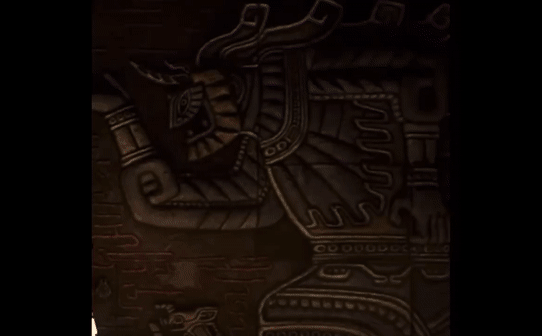
The flip side of this would be to make Ganondorf a poor little meow meow that was secretly controlled by the evil Demise all along, and... I’ll be real. I really don’t think it solves our problem at all. It might even make it worse.
My problem with how gerudos have been handled thus far, being mostly connected to how they behave in relation to hylians Good, is that they’ve been systematically defanged not to threaten the status quo as much as they used to. I think it’s pretty clear why I’m not a fan of Ganondorf being a mere victim of cosmic circumstances; I have a post that goes more in depth about this, but to simplify: my man has legitimate grievances. To make him a mere puppet to Evil Incarnate would, to me, be just another attempt to erase the despotism of the Goddesses, the unjust hierarchy of the world, what hylians have historically done to the races they were in conflict with (looking at the Yiga for the most recent example…)
I’m not saying his fight is clean or even legitimate, that he isn't driven by his own sense of self-importance above anything else, or that he should win (he has no plan beyond domination and victory, that's not a future). But I think there’s something really important about having someone being willing to fully consume himself and everything around him for the simple fact that someone should resist the order of the world. Even if that makes him a heartless, cruel, and egomaniac demon-pig. Even if there’s no Hyrule left to rule. Even if his own people despise him, or are long gone and forgotten.
Is it a little heart-wrenching? Uhh yes to me yes most definitively. This is why Wind Waker Ganondorf hits so hard, and remains (I think) his favorite entry in the series so far. But… I still find this fate of eternal resistance more resonant and empowered, and far less grim, than if Hyrule’s lore absorbs his hatred and rage, gives it to another entity that would be Badder (= more opposed to hylians and the goddesses), and scrubs it off anything icky and uncomfortable, rendering it completely domesticated and non-threatening to hylian domination; rubbed of his skin color, of his complexity, of his own emotions, even made... kind of sexy now, in the same way his sisters have been made before him? I am very, very afraid of him being turned from furious and an unapologetic subject in his own legend to a "redeemed" (according to whom??) and palatable object in somebody else’s, that you now end up having to… save from himself.
Again, I want to trust that Tears of the Kingdom can walk that line and preserve everything sharp and contrasting and profound and thrilling about this fascinating setup. I don’t expect a philosophy course, this is a game for children –but it doesn’t mean Nintendo didn’t do an astounding job with similar setups in the past. Again, I’ll invoke the Wind Waker conflict, but Twilight Princess did a lot of great things as well (Zant’s speech, if you can get past the weird stretches and stumping and NNHYAAAs, is pretty fantastic) –and the subtle writing of Majora’s Mask is also proof enough this series can be complex without being impermeable.
So this is where my hope lies. Not really with BotW’s writing, which, I’m sorry to say, but I found to be below what the series has done in the past (I have no problem with the setup and how the story is explored, I think it was a great idea, but wasn’t ever sold on the actual writing the way I may have been with previous titles –it felt… very tropey to me overall, with a couple of highlights). But Nintendo has shown to know how to write compelling stories for children that know where to sprinkle its darkness and how to preserve its hope, and this is this side I’m relying on for this delicate storyline moving forward.
And now? Now… I suppose we wait and see.
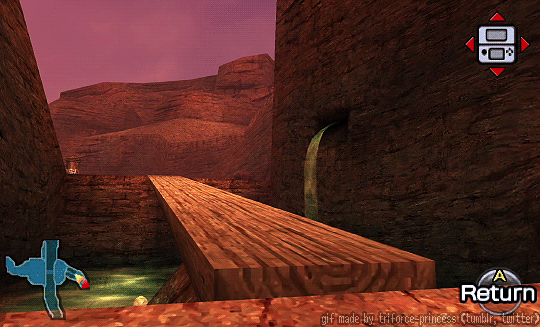
(thank you for reading my impossibly long essay what the actual hell, at least I got it all out of my system, see you in part 2 for when TotK comes out I suppose aaa)
#gerudos#gerudo#ganondorf#tloz#totk#botw#breath of the wild#ocarina of time#twilight princess#wind waker#ww#tp#meta#hylian critical#zelda meta#thoughts#this took SO LONG#but at least it's DONE#let me know if I say stupid things!!#I probably do!!
889 notes
·
View notes
Text
So I’m working on a lil botw music project
Basically I’ve heard many people complain that this game has no real overworkd theme, so I tried to imagine what it would’ve sounded like. It’s not done yet, and very experimental, so bear with me here.
I tried to combine the minimalistic texture of the original soundtrack, but still adding more “action”. I’ve clearly used leitmotifs from the Hyrule castle theme, mainly to represent how despite the open world and countless side quests, the calamity is always looming in the background. Thinking of incorporating more leitmotifs into the song, possibly something representing the Stables and Riding tracks.
Also huh headphones warning???? This is rlly loud because I messed up the mixing big time… make sure to turn down your volume lol
#eli’s music#not an art post#music#composition#original music#original work#wip#music wip#work in progress#botw#botw 2#totk#Zelda#breath of the wild#botw ost#botw meta#the legend of zelda#legend of Zelda#legend of zelda breath of the wild#loz botw#loz#zelda music#loz music#Nintendo#Nintendo music#Nintendo soundtrack#fan music
26 notes
·
View notes
Text
botk link and zelda were always fated to care for each other that much. because of the ontology of time travel the fact that they exist at all is literally proof of it
if two of the same people enter a timeloop (A and B) with each other, A will become B who will eventually break out of it and leave the loop. each of these take place at their respective “presents”, so what is future and past is relative. (excuse the hs but it illustrates my point perfectly)
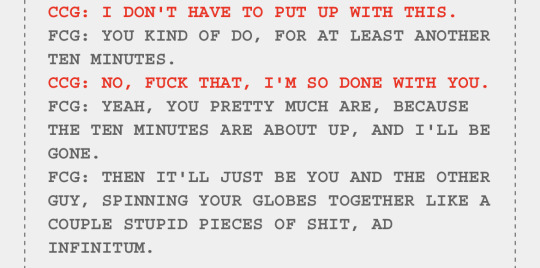
it was always destined to happen that zelda would get the stone. she is locked into that reality, it needed to happen. if she didn’t, rauru would have no one to place his bets on and ganondorf probably wouldve taken over hyrule completely. zelda likely wouldn’t have been born in the first place (or link for that matter).
when looking at the source of events that follow (zelda and link descending under the castle and finding ganondorf and the stone), they seem to be unrelated to anything else that caused them. zelda becoming a dragon does not change where she originated from since she had to originate from somewhere, and she tells the founding king and queen that she is the daughter of king bosphoramus hyrule, meaning her origin is in fact from the future relative to that time.
these are paradoxes that typically get solved by calling them spontaneous.
her birth was of seemingly spontaneous origin (and zelda did exist as a dragon at the same time of her birth, but the light dragon’s relative position exists much later on her own timeline). but it was also zelda’s precise actions that enabled the conditions for her birth in the first place (in a way similar to the paradox clones in homestuck, a case of an ontological paradox). hyrule castle was literally erected to hold the seal rauru had on ganondorf, and rauru could only have made that sacrifice to bind his magic after trusting the future for the swordsman zelda mentioned, link. it was a shot in the dark; if zelda didn’t have that much trust and conviction in link and speak so highly of him, rauru likely wouldn’t have made that sacrifice since it would’ve had no faithful payoff, have only delayed the inevitable for future generations to deal with without any certainty that they would be defended. ganondorf likely would have slaughtered his opposition and hyrule’s future would’ve been much, much different from how we know it now.
zelda and link’s love and trust for each other is quite literally responsible for the conditions for their existence in the first place. if their love and loyalty to each other isn’t 1000%, they don’t exist and neither does hyrule as we know it. their love and care for each other spans AGES and is literally singlehandedly responsible for keeping hyrule as it is instead of a hostile dangerous gladiator existence like ganondorf’s ideal world. since they were, in fact, born, they were always fated to care for each other this much, like ontologically.
527 notes
·
View notes
Text
Okay SO. Theory Rush after finishing Tears of the Kingdom. Go.
The Zonai are said to have descended from the heavens to help found Hyrule. I can think of another race that descended from the heavens. Do you guys think the minish are native to the Zonai sky islands?
Does the Depths set look a little familiar to you? This along with Josha's theory that people once lived down there, I wonder if the interlopers were present in the Depths before being banished to the twilight realm.
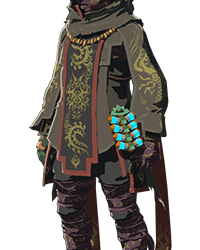
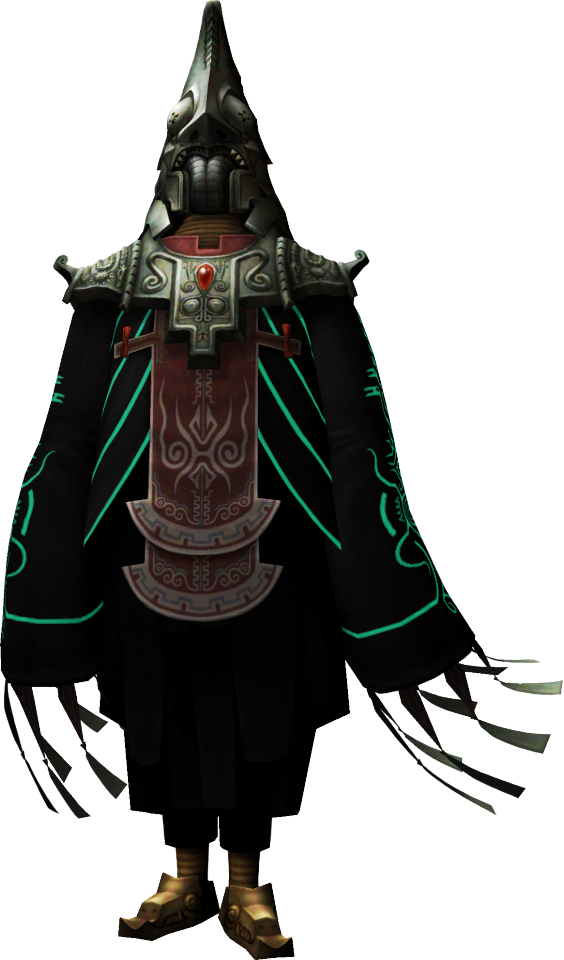
The architecture and robot designs from Skyward Sword have a distinct Zonai look to them! So that leads me to believe the Zonai were the race that created the Lanayru Mining Facility.


It might even be that the Past from Skyward Sword is indeed the time period that Zelda was transported back to! Maybe the legacy of the kingdom of Hyrule goes back even further than the fight between Hylia and Demise: though I admit the early appearance of Demon King Ganondorf throws a wrench in this theory.
About secret stones and the amber relics in Skyward Sword: I want to say there's a connection between them, though amber relics don't seem to be as rare and important as secret stones, (we find them in abundance in Skyward Sword and they don't do much). Of course, i haven't played SS in a while so if they have any more significance it's escaping me at the moment. For the time being I'd like to think ancient hylians might have carried them around as good luck charms to emulate secret stones of their own.

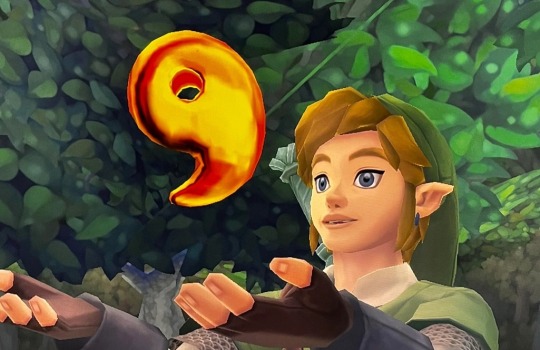
The Legend of the Great Sky Island mini quest in has the construct telling us that the island was supposed to be where a hero will one day awaken to defeat the Demon King. I know our Link wakes up on this island, but there's definitely something eating at my brain about the Great Sky Island being related to (or perhaps even IS) Skyloft, and that the awakening of the hero is referring to Skyward Sword Link. (This potentially supports the theory that the Past in TOTK predates the war between Hylia and Demise)
There's a pretty good chance that Rauru and Sonia's child could have been named Zelda, after the sweet time traveling girl they practically adopted :) the first princess of Hyrule named after the last princess of Hyrule.
There is a giant dragon skeleton in the Gerudo Desert Depths, big as or even bigger than Farosh, Dinraal and Naydra. It is my belief that this mystery dragon became a dragon ala Secret Stone alongside the three aboveland, but was killed at some point in the Depths. I don't know what four people decided to become dragons, but my strongest theory is that Dinraal, Farosh and Naydra are the draconified forms of the oracles of the Golden Goddesses, Din, Farore and Nayru. So who is this?
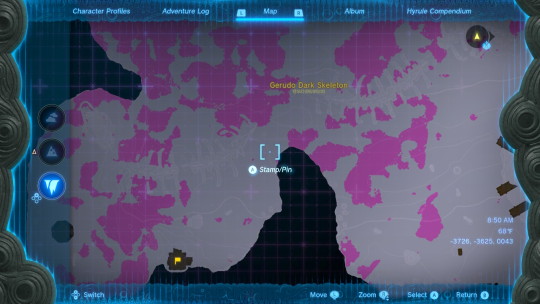

Seeing as the Lightroots underground are activated via Zonai hand terminal and each Lightroot lies directly beneath a shrine on the surface, I think the Lightroots are extensions of these shrines, having grown straight downward to light up the underground. This is probably obvious but I just barely figured this out 😅
Since Rauru, sage of light, and a new Temple of Time are in this game, I want to think that this person and location are more than just Easter Eggs to Ocarina of Time. I think that the sage from Ocarina of Time was named after King Rauru, though I'm not sure whether him being the sage of light would have been a coincidence or a direct inspiration.
What I do think is that he indeed did put the triforce in that very same Temple of Time and all the sky islands went to the Sacred Realm until Tears of the Kingdom, when they came back to earth and appeared in the sky. That's just a theory but why else would the sky islands be reappearing as if from nowhere?
Speaking of which, there were floating masses in the sky in Minish Cap, namely great big stone temples and fortresses. Minish Cap takes place during the early days of Hyrule, which would be pretty much right after the Zonai descended. Perhaps the Zonai are the Wind Tribe mentioned, and the people we see in game are their descendants, who look much more hylian than Zonai due to being crossed with full hylian genetics over the generations?
Anyway I need to retouch up on my Zelda lore to make sure I'm getting the details right, (that, and i haven't yet 100% the game so i may be missing some totk context), but I HAD to post my thoughts and get them out there! I'll add on later if I think of any more, in the meantime feel free to brainstorm!
#totk#tears of the kingdom#totk spoilers#tears of the kingdom spoilers#botw 2#botw 2 spoilers#just covering all my bases#totk theory#totk thoughts#totk meta#loz#legend of zelda#the legend of zelda#loz totk#wicked.loz
518 notes
·
View notes
Text
Can we analyse Tulin for a bit?
Apart from being the keet birb boy, perhaps what makes his character so enthralling is how it so brilliantly reflects and offers commentary on the influences that have shaped him.
Whether that be Revali, his father Teba, and ESPECIALLY Link. Hell, it's no wonder that Link & Tulin have garnered such a sibling dynamic. Tulin essentially IS Link, from a time before the burden of responsibility and pain caused Link to cave in on himself pre-Breath of the Wild.
Right down to the veteran warrior father figure (Link's father was captain of the guard) and their acceptance of a newfound legacy out of forthright integrity. Tulin, at this point in his life, has yet to give himself away until there's nothing of him left to give, and let's pray he never needs to.
But Tulin would do that in a heartbeat, if called upon. He is very much his father's son.
You can see it in how archtypical childish spunk is tempered, like steel, by Teba's down-to-earth bluntness and sheer work ethic.
(BTW I wonder if Link sees his own father in Teba? That'd check out.)
But what caught me most pleasantly off-guard is Tulin's skepticism, which has become one of his most compelling traits for me. It's not something you would expect.
He did not believe that the Stormwind Ark existed, and while ultimately proven wrong, it frankly wasn't an illogical assumption to make. Tulin clearly thought through that opinion. He'd also grown frustrated that the Rito placed their faith on a songbook miracle — a eucatastrophe, if you will — instead of something more concrete like personal skill or, say, Link's whole-ass existence.
The second Link arrived and offered his aid, Tulin accepted his help without hesitation. He turned his skepticism inward to reevaluate his own tenets. And it's as a duo that they brought about said eucatastrophe through no one's strength but their own. They are siblings, Your Honor. Aryll 2.0
(If Revali had been blessed with a support network saying "it's okay to accept help. no man is an island," doubtless he still would have perished in Vah Medoh. But there would be less of an ego to shatter. He would have faced death with less blind panic and more dignity. And most importantly, he'd have other people to bolster the wind beneath his wings during his short life.
(At the very least, Revali would not have as big an ass not be as big an ass, just as Tulin would be a different person without his family.)
dammit quaquaval you have RUINED me
Also, one thing that everyone seems to miss is just how deceptively intelligent Tulin turns out to be. This kid fuckin' knows his stuff. His mastery of aerodynamics beyond the instinctual is almost on par with Revali at such a young age. And how many precision headshots has his avatar saved your ass with, don't lie.
He somehow managed to follow his father back through time. Tulin can see Koroks.
It's not the same kind of passion-fuelled intellect as, say, Zelda has. More of an unyeilding conviction to learn all he can and put it into practice. About as understated a quality as Yunobo's inexplicable business acumen and economic sense.
As his mother Saki put it, for Tulin to develop as an individual, he needs to experience more of reality and its hardships. Shooting bullseyes and improving one's flying prowess / wind magic can't contend with genuine combat. True to her word, Tulin had to experience mistakes firsthand, and critically examine his own naïve ways of thinking in order to take those necessary steps.
...
So then, uh, is it wrong for me to wish something horrible upon him, if only to witness the positive character growth that springs from it? Tulin isn't the sort who'll shatter under pressure, like Revali did at the end of his life, or like Link did under the weight of expectation. Buckle, yes — but not break. Tulin's steadfast conviction, inherited from his father and guided by the people he loves, would assuredly see him through.
In any event, his Hero's Journey isn't close to over. I'd be curious to see Tulin at its conclusion.
tl;dr I wanna Emesis Blue his bitch-ass, AITA?
#character analysis#tulin#loz#legend of zelda#botw#breath of the wild#totk#tears of the kingdom#teba#link#revali#tulin totk#rito#rito botw#tulin of rito village#sage of wind#meta#korok#sibling dynamics#aoc#age of calamity#aryll#yunobo#eucatastrophe#quaquaval#emesis blue
768 notes
·
View notes
Text
So there's a take that crops up every so often in the Breath of the Wild fandom, and it goes something like this:
Windblight Ganon is such a piece of cake! If Revali were as talented as he claimed to be, he wouldn't have been defeated by it, so clearly he's just an arrogant blowhard.
I disagree. Because while Windblight might have been relatively easy for the player to defeat, circumstances conspired against Revali in every possible way.
Strike 1: The Blight Ganons were tailor-made to defeat the Champions
While it's not stated outright, the Blights seem to be custom-made to put their respective opponents at the worst possible disadvantage. So while Link can avoid the whirlwinds on the ground, they would be very disruptive to Revali's Gale (something he's only been able to do consistently for a short while). Arrows, too, can easily get blown off course by the wind even when using a heavy bow (so can a Rito, who is presumably lighter than a Hylian).
If, on top of that, it was raining (implied by memories #16 and #17), then Revali's favoured bomb arrows would have been useless. Not a great recipe for a fight.
Strike 2: Rito don't see well in the dark
Botw is a game that doesn't tell you a lot upfront, but you can find a wealth of information in every little corner. Case in point, in Gerudo Town there's a Rito named Frita. And she has a very interesting tidbit to share if you talk to her at night.

[Image ID: A Rito named Frita in Gerudo Town says: "Us Rito... We haven't got the best night vision, to be honest."]
When the Calamity emerged, an unnatural darkness blanketed the land. A darkness that persists from its appearance all the way through Link and Zelda fleeing and their final stand at Fort Hateno, up until Zelda temporarily sealed the Calamity (memories #15, #16 and #17).
That’s without even mentioning the laser show Windblight Ganon puts on. Ever encountered a car with LED lights on a dark road? Now imagine how Revali felt.
Strike 3: Revali had to fly non-stop for hours to get to Medoh
After sinking some hours into playing botw, you probably get used to warping all across the map via the shrines. Going from Lurelin to Rito Village is a matter of seconds. And if the Sheikah had been able to unlock the Sheikah Slate fully in the past, that would have been a massive boon to the war effort.
Unfortunately, they didn't. Which means that, when Calamity Ganon emerged, all the Champions had to take the long road to their Divine Beasts.
Now what does that mean for Revali? We can hazard a pretty good guess, but we don't have to, because the art book tells us: Revali flew straight from Lanayru East Gate to Rito Village. It's hard to tell exactly how long that would have taken him, but I'm estimating that would be about 8-10 hours flying non-stop.

[Image ID: A map of Hyrule showing the presumed routes the Champions took to get to their Divine Beasts. Revali's is a straight line across Hyrule.]
Which means Revali (like the other Champions) was probably already exhausted by the time he got to Medoh.
Aaaaaand that's three strikes, he's out!
But if that's not enough for you yet, here's one more thing. Admittedly, this is less solidly canon than the previous parts, but it's conjecture that, in my opinion, is backed up by the Champions' Ballad DLC.
Strike 4: Revali lacked his best weapon and may have been injured
The artbook shows us another salient tidbit. Revali could have detoured if he wanted to, but he didn't: he flew in the straightest possible line across Hyrule Field.
Hyrule Field, better known as the center of the chaos at the time.
Can we really expect a Champion, especially a Champion who's so eager to prove himself, to not stop and at least try to help? And while trying to help, what might have happened to him?
When you fight the Blights in the illusory realm, you gain a set amount of equipment, implied to be what the Champions carried with them at the time. And with Revali, something's missing.

[Image ID: The bow inventory during the DLC fight against Windblight Ganon. It includes a Falcon Bow, Duplex Bow and Phrenic Bow.]
Where's the Great Eagle Bow?
Would Rito Champion Revali, greatest archer in known Rito history, really not be carrying his signature bow, when every other Champion carried their favoured weapon?
This, combined with his route straight across Hyrule Field, makes me suspect that he did engage the Guardians, lost his bow, and may even have gotten injured in the process.
So there you have it. Just about everything was against Revali in that fight. And while Link, and by extension the player, may have had an easy time of it, they went into it at full health and with all the advantages of the Sheikah Slate.
Meanwhile, Revali arrived at Vah Medoh after a frantic hours-long flight only to be thrown into a fight he didn't expect against an opponent tailor-made to counter his every move, while he was unable to see properly and lacked his best weapon. And he still managed to put up one hell of a fight.
#botw#revali#meta#look I didn't write my first botw fic about this very thing just to have this nonsense persist#Revali is exactly as good as he claimed to be#and the Champions were thrown into a fight that had them at a massive disadvantage#(sidenote: Urbosa doesn't have the Thunder Helm either even though it probably could have saved her)#(Presumably she didn't want to detour when they were so pressed for time and she didn't expect a fight on Vah Naboris)
907 notes
·
View notes